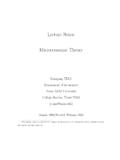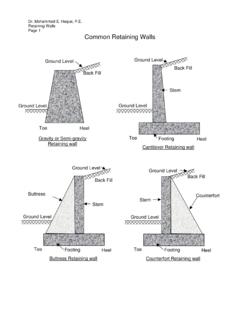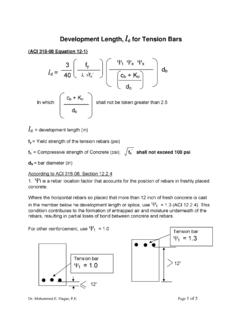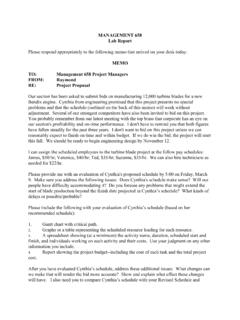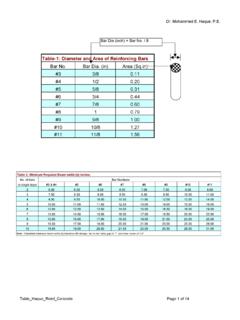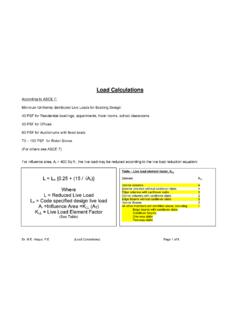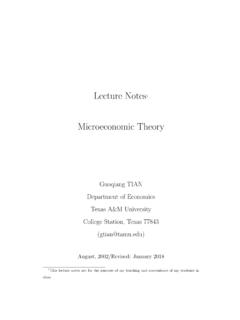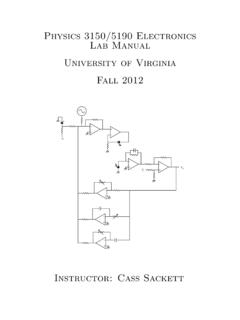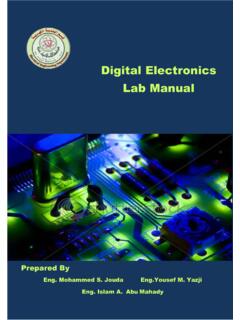Transcription of Laboratory Exercise #1 Digital Logic Gates
1 Laboratory Exercise #1 Digital Logic GatesECEN 248: Introduction to Digital DesignDepartment of Electrical and Computer EngineeringTexas A&M University2 Laboratory Exercise #11 IntroductionDigital circuits makeup the cornerstone of modern computational hardware. By representing binary digits( {0,1}) with voltage levels, Digital circuits are able to process binary numbers the fundamental components within Digital circuits so understanding their behavior is , the purpose of this experiment is to introduce you to gate behavior and Logic interpretation aswell as the basics of circuit wiring and troubleshooting. To do so, we will explore the function of several ofthe basiclogic gatesdiscussed in BackgroundBackground information necessary for the completion of this lab assignment will be presented in the nextfew The 7400 Series of Logic GatesLogic Gates are constructed from transistors, which are analog switches. These transistors can be forced tooperate in two modes, namely ON or OFF.
2 In doing so, we can abstractly think of electronic signalswithin a Digital circuit as being either HIGH or LOW ( 1 or 0 ). A Digital gate takes as input oneor more Digital signals and outputs a Digital signal as a result of a boolean operation. Figure 1 depicts thestandard Logic gate symbols and their associated boolean 1: Logic GatesThe basic Gates you will study in lecture are available in a series of Integrated Circuits (ICs) commonlyreferred to as the 7400 series. Within this series, there are various IC package types available; however, forbread-boarding Digital circuits in the Laboratory , we will use the Dual-Inline Package (DIP) type as shown2 ECEN 248 Laboratory Exercise #13 Figure 2: Dual-Inline Packagein Figure 2. As shown, the DIP features a black plastic package with pins on both sides, slightly resemblinga flat 3 shows the DIP pinout diagrams for the NOT Gates (left) and the AND Gates (right). These pinoutdiagrams were taken from their respective datasheets and illustrate the function of each pin within a giveIC package.
3 Notice that the DIP on the left (7404) contains six NOT Gates arranged in a counterclockwisefashion starting at the top-left of the IC. The DIP on the right (7408) contains four AND Gates arranged in asimilar fashion. Also note that the notch on the DIP designates the top of the IC 3: 7404 (NOT) & 7508 (AND) Pinout Bread-boarding TechniquesThe first four labs require extensive bread-boarding of Digital circuits. The bread-board used in ECEN248is depicted in Figure 4. Take a moment to examine it. Here are a few techniques which will help you wireup your circuits:ECEN 24834 Laboratory Exercise #11. Horizontal lines of points on the bread-board are electrically connected together. However, lines arenot connected across the partition divisions ( lines in different partition are independent).2. Vertical line areNOTelectrically connected, except in the case of a power or ground line (see Fig-ure 4).Figure 4: Twin Industries TW-E41-1060 Bread-Board3.
4 Power and Ground lines shown vertically in Figure 4 are electrically connected. In lab, you willconnect the 5V supply to one of the pins in the Power line. This will connect the entire column to the5V supply. Similarly, the Ground signal needs to be connected to one pin in the Ground All the Integrated Circuits (ICs) in the design should be placed across one of the partition divisionsas shown in Figure 4. Do not place an IC in only one partition because this will short pins togethercausing the IC to burn Wires connecting different IC pins should traverse horizontally or verticallyonly. Do not connectwires diagonally across the breadboard as this will result in a messy design making it difficult 248 Laboratory Exercise #156. Use smaller wires when connecting nearby points on the breadboard. Please use wire strippers toshorten wires if smaller sized wires are not available. This will help keep your design clean and easyto You may decide to always place the IC in such a way that the notch is located on the top (or bottom)as shown in Figure 4.
5 This may help you identify pin numbers. Similarly, it might be a good ideato use color codes while wiring up your design. For example, you could assign black wires to theleast significant bit, white wires to the next significant bit, green wires to the next, and red wires forthe most significant bit. The color code and order of assignment is entirely your choice and for yourconvenience in identifying wire connections while Before placing the components on the breadboard, plan the placement of your ICs such that it mini-mizes wiring distance on the breadboard. ICs with high connectivity should be placed near each example, if LED display inputs are connected to OR gate outputs, then try to place the OR gateIC as close as possible to the LED Components and EquipmentThis section will provide you with a brief description of some of the components and equipment you willbe using throughout the 5: 74 ALS04 pin-out1. Figure 5 shows the pin-out of a 74 ALS04 inverter chip.
6 With the IC notch towards left, the pinnumbers are counted in a clockwise direction as shown in the figure. The left most pin on the bottomrow is pin 1 and the left most pin on the top row is pin 14. Never connect the output of an inverter tosupply or ground as this will damage 24856 Laboratory Exercise #1 Figure 6: 16-pin DIP Switch2. Figure 6 depicts a DIP switch, which is a set of electrical switches that are packaged in a standardDual In-line Package (DIP). This type of switch is designed to be used on a printed circuit board orbread-board along with other electronic components and provides user input to a Digital circuit. DIPswitches usually come in packages with eight switches. The eight switch package offers up to 256total combinations. In this lab class, we will use these DIP switches to read in a 0 (Off condition) ora 1 (On condition) from the In Figure 7, pictures the multimeter use in lab. A multimeter is an instrument used to measure cur-rent, voltage, resistance etc.
7 The knob in the center of the multimeter is used to select the mode ofoperation, while the measured values can be read on the LCD display. Please note that the modes ofoperation include various precision settings in addition to the type of measurement. The multimeterprobes plug into the appropriate holes towards the bottom of the multimeter, depending on the type ofmeasurement being The oscilloscope, shown in Figure 8, is a device which can display waveforms of signals with respectto time. The Tektronix TDS2022 has 2 channels and supports a bandwidth of 200 MHz. Two channelsenable us to view two different waveforms simultaneously on the LCD screen, each measured witha different input probe. Alternatively, we can change the settings on the front panel to display onlyone of the two channels at a time. Each channel has a vertical position knob and a Volts per Divisionknob. One time per division knob controls both The power supply used in lab is depicted in Figure 9.
8 In this lab, mostly we will be using +5V as mostof our Digital ICs operate at these supply voltages. If you need a second power supply, you can usethe +20V supply adjusted at the required voltage 248 Laboratory Exercise #17 Figure 7: Extech Instruments model MN36 auto-ranging Multi-meterFigure 8: Tektronix TDS2022 OscilloscopeECEN 24878 Laboratory Exercise #1 Figure 9: HP6236B Power Supply6. In lab, we will be using a function generator to provide various types of signals as input to our a Digital lab, a function generator is a great clock signal source! Figure 10 depicts the functiongenerator in 10: HP33120A Function Generator7. For the later labs, we will be programming more complicated Digital circuits into the FPGA boardshown in Figure 11. Field Programmable gate Arrays (FPGAs) provide a tremendous amount ofreprogrammable Logic within a single IC package. The development board allows us to evaluate the8 ECEN 248 Laboratory Exercise #19 Figure 11: Spartan-3E Development BoardFPGA without the need for fancy soldering machines!
9 3 Pre-labThe will demonstrate the use of the oscilloscopes, power supplies and multimeters in the beginning ofthis lab. No formal Pre-lab submission is required for this lab assignment4 Lab ProcedureWe will look at the behavior of Logic Gates in Figure 1. Each of these Gates is embedded in an integrated cir-cuit package. Consult the datasheets of each component for the pin-outs, electrical and timing characteristicsof these circuits. All datasheets are available on Experiment 1We will start by setting up the DC power supply and multi-meter for our use. Be sure both are turned check to see that the multi-meter is set to measure DC, and be sure the red lead is connected to the redmulti-meter input that is marked for voltage. Finally, set the scale to the range you need to measure (usu-ally between 0V to 5V for Digital circuits). Now, set the DC power supply voltage output to zero (turn theECEN 248910 Laboratory Exercise #1coarse adjustment counterclockwise until it stops).
10 Connect the red lead of the power supply to the red leadof the multi-meter. Likewise, connect the black lead of the power supply to the black lead of the :Do not connect Power (RED) and Ground (Black) together. This will cause a on both the multimeter and the power supply. The multimeter should read very close to zero. Turnthe coarse adjustment clockwise until the multimeter reads 5V. If the multimeter display does not changesignificantly when you turn the coarse adjustment, turn the power supply off and recheck your may have a short. When the multimeter reads 5V, the adjustments are complete and you should turn offthe power supply. You are ready to test your first gate . We will start by wiring a 74 ALS04 (inverter) refer to the pin configuration given in the 74 ALS04 datasheet. Insert the 74 ALS04 chip onto thebreadboard. Be sure you are not shorting pins together. Identify the power (VCC) and ground (GND) pinsfor the 74 ALS04 from the pin-out of the 74 ALS04 in the datasheet.

